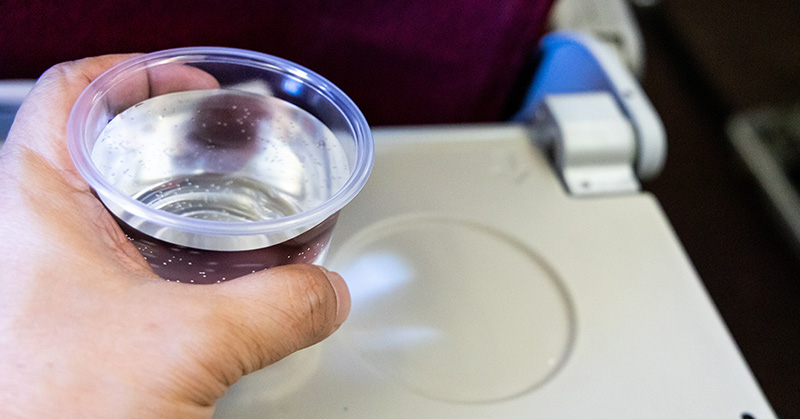It is no question that safety is the top priority for any airline and it’s also the number one concern for most airplane passengers. Airline’s spend exorbitant amounts of money every year conducting exhaustive tests making sure their planes are ready for any scenario that could threaten the safety of each flight [1]. Passengers can sit back, enjoy the in-flight entertainment and rest assured knowing that the aircraft has been tested, re-tested and tested again.
But does the airline’s commitment to passenger safety stop at the plane itself? A recent study published by dietdetective.com revealed that this might be the case.
Aircraft Drinking Water Rule
In 2011, the Federal Government implemented the ADWR, or Aircraft Drinking Water Rule, which legally required airlines to provide clean water for staff and passengers to drink. According to the law, airplanes are classified as public water systems and so must adhere to the requirements of the Safe Drinking Water Act (SDWA) [2].
Until the ADWR was written, safe drinking water regulations were written under the same principles as stationary water systems, such as schools and restaurants. Airplanes, of course, provide unique challenges with regards to food and drink health and safety, and it appears now that despite these new regulations, water safety on air crafts is still an issue.
The Study
The study, published in partnership with the Hunter College NYC Food Policy Centre, revealed that the majority of U.S. airlines are serving passengers unsafe drinking water [3]. The study gave a “Water Health Score”, ranging from 0-5 to ten major airlines and thirteen regional airlines [3]. The score is calculated from 10 criteria that include fleet size, ADWR violations, positive E. coli and coliform water sample reports, and cooperation in providing answers to water-quality questions [3].
So Who Made the Grade?
Allegiant and Alaska Airlines received the best score at 3.3, followed by Hawaiian Airlines at 3.1. It is important to note that only scores of 3 or higher are considered safe to drink. All other major airlines, including Southwest, Delta, American Airlines, United Airlines and Jet Blue, scored below the 3-point threshold, with Spirit and Jet Blue coming in last at a score of 1.
The regional airlines in the study did not fare much better. Piedmont Airlines was the only carrier that received a score above 3, at 4.33. Republic Airways (which includes United Express, Delta Connections and American Eagle) received the lowest score at 0.44.
Who Regulates the Water?
Water safety on flights is regulated by 3 government agencies: the Food and Drug Administration (FDA), the Federal Aviation Administration (FAA), and the Environmental Protection Agency (EPA). Each of these administrations uses the ADWR to wield their regulatory powers [4].
The FDA regulates where air carriers obtain their water at airports, such as water trucks, carts, and hoses, to make sure the water doesn’t get contaminated during the transfer process onto the plane. If any watering point does not meet FDA standards, the FDA has the power to ban air carriers from obtaining water at that source.
The FAA regulates the operation and maintenance of potable water systems on aircraft. Potable water refers to water that is safe to drink. The EPA is responsible for the safety of the water once it is actually onboard the aircraft [5].
What Has Gone Wrong?
All the water used on an airplane for handwashing in the lavatories and making tea and coffee on the plane is held in a large tank. Shockingly, air carriers are required by the Environmental Protection Agency (EPA) to clean out these tanks only 4 times per year [3].
Additionally, an aircraft flies to hundreds of destinations and obtains water from a variety of sources. This provides an even greater challenge to ensuring the cleanliness of the water.
All of these factors increase the likelihood that there will be E. coli or coliform bacteria in the water, which has the potential to make passengers very sick.
It is also important to note that the “Shame on You” award was given out by the researchers to the EPA and almost all major airlines for their reluctance to answer detailed questions [3]. The EPA didn’t even answer most penalty-related questions.
So What is a Passenger to Do?
Unfortunately, it is up to you, the passenger, to take the necessary precautions to protect yourself from becoming ill. In order to avoid spoiling your next vacation or trip with illness, Dietdetective.com and the Hunter College NYC Food Policy Centre offer 3 suggestions [3]:
- Never drink any water that did not come from a sealed bottle.
- Do not drink coffee or tea on-board the plane.
- Bring hand sanitizer with you so you don’t have to wash your hands on board the plane.
- https://www.bbc.com/future/article/20140319-stress-tests-for-safer-planes
- https://www.epa.gov/sites/production/files/2015-10/documents/aircraft_drinking_water_rule_training_part_1_introduction_pdf.pdf
- https://www.dietdetective.com/airline-water-study-2019/
- https://www.dietdetective.com/airline-water-study-2019-faqs/
- https://www.dietdetective.com/background-airline-drinking-water-rule-and-other-helpful-information/

